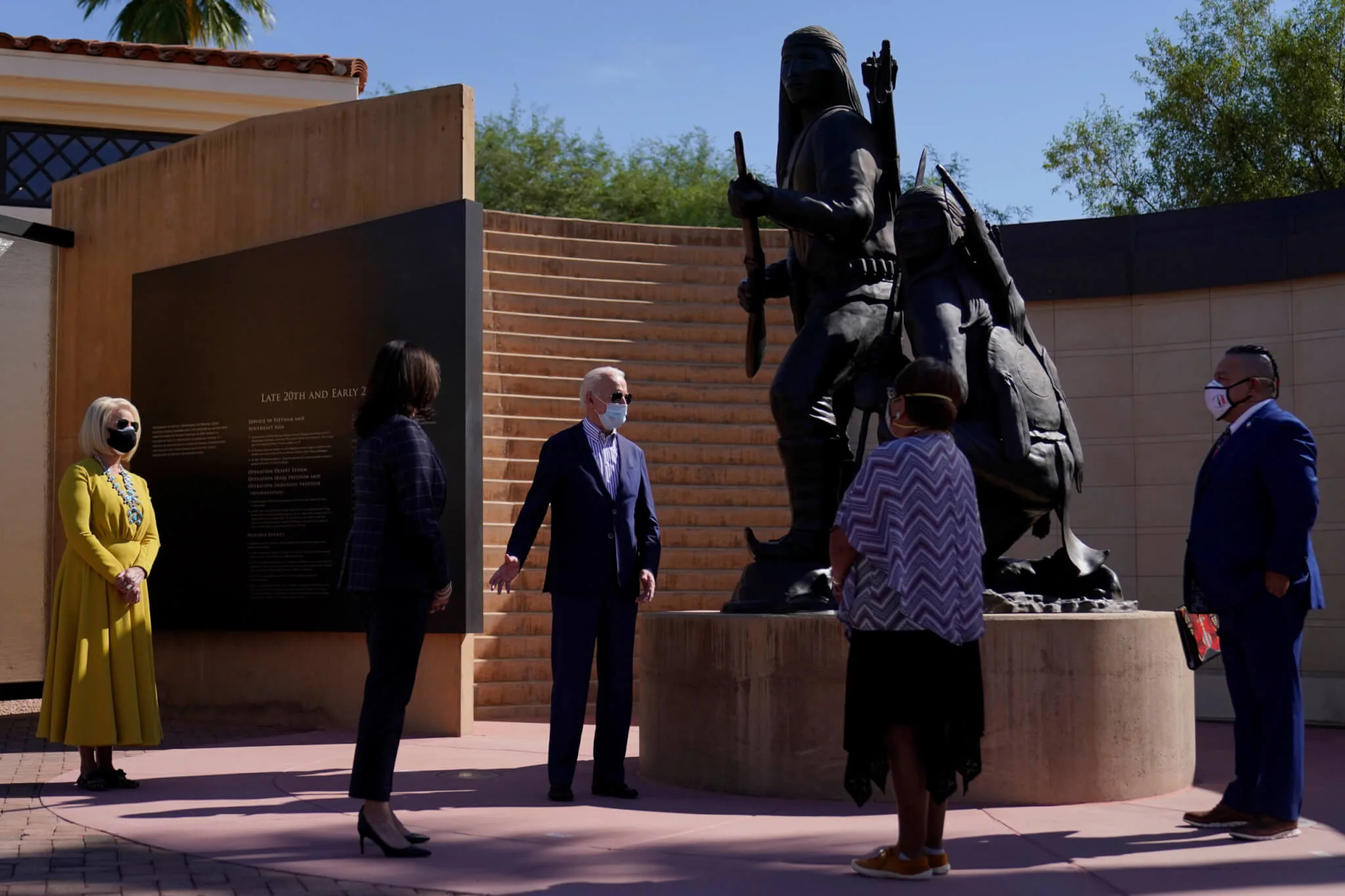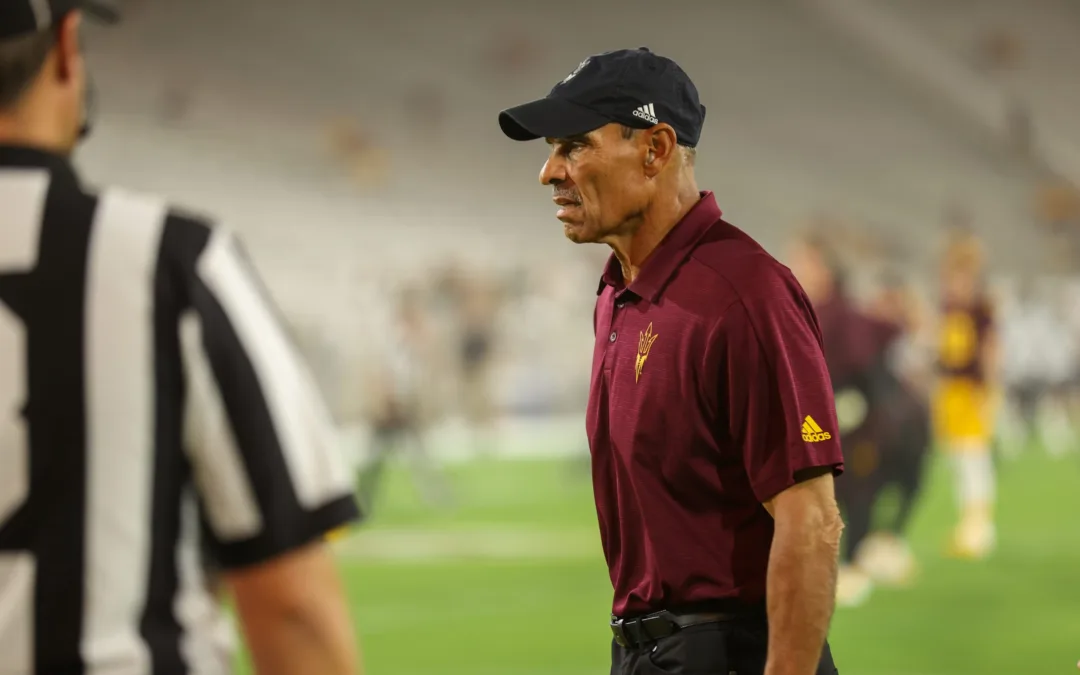
From left, Cindy McCain, vice presidential candidate Sen. Kamala Harris, D-Calif., and Democratic presidential candidate former Vice President Joe Biden, visit the American Indian Veterans National Memorial with tribal leaders and veterans at Heard Museum in Phoenix, Thursday, Oct. 8, 2020. (AP Photo/Carolyn Kaster)
The proposal includes promises to uphold federal trust responsibilities by addressing health disparities, providing economic opportunities, and restoring indigenous lands.
Last week, presidential candidate Joe Biden and vice-presidential candidate Kamala Harris talked about their plans for Native American nations during their joint visit to Arizona—an important battleground state in this year’s election.
The Democratic presidential ticket released a detailed 15-page plan, according to Indian Country Today, to uphold federal trust responsibilities by addressing health disparities, restoring indigenous lands and providing economic opportunities for Native Americans.
This plan, made public just before Biden and Harris met with Arizona Nation leaders in Arizona, would also build on efforts made by the Obama administration.
The Democratic duo also visited the Heard Museum where they TKTK…
Indian Country Today also reports that at the forefront of the Biden-Harris plan for Native Tribes are goals to strengthen the nation-to-nation relationship between tribal nations and the federal government.
They would do that, in part, by reinstating the annual White House Tribal Nations Conference, where tribal leaders meet directly with the president and his staff to address issues that affect their communities.
Inclusive Representation
The Biden administration also promised to appoint Native people to high-level government positions, as well as nominate judges with a true understanding of federal Indian law. They would also launch a budget task force to address funding shortfalls.
The Democratice presidential ticket also took the opportunity to pitch an economic message while kicking off their bus tour in Phoenix. This was the first time Biden was in Arizona as an official presidential nominee.
Harris introduced the former vice president by reminding people of Trump’s “reckless disregard for human life and for the well-being of the American people” when it comes to the coronavirus pandemic. She asked Arizonans to vote “like your life depends on it,” because, she said, “it really does.”
Biden then told a union crowd, “You’re facing real challenges right now, and the last thing you need is a president who exacerbates them, who ignores you. We’ve paid too high a price already for Donald Trump’s chaotic, divisive leadership.”
Arizona’s 11 Electoral College votes could very well tip the scale to either side. In fact, Vice President Mike Pence was also campaigning in Arizona that same day.
A Dramatic Shift
Arizona’s transformation seems drastic since a mere 10 years ago the state was the epicenter of Republicans’ push against anti-illegal immigration push. With early voting underway and millions of ballots in the mail, the home of pathbreaking Republicans from Barry Goldwater to John McCain to Sandra Day O’Connor is a top Democratic target this year, and some Republicans are anxious.
While the Trump campaign projects confidence in a state the president won by 3.5 percentage points four years ago, it’s notable that Thursday marked Pence’s fourth trip to the state this year, on top of Trump’s five trips in 2020.
“I didn’t think it would happen this soon,” said former Republican Gov. Jan Brewer of the shift. Brewer rose to national prominence when she signed the state’s anti-illegal immigration law in 2010 and publicly feuded with then-President Barack Obama. “But I think we have done a bad job of trying to educate them, the new population, that they ought to be Republican.”
Veteran lawmakers and political operatives point to three main factors driving Arizona’s move away from Republicans: Democratic-leaning newcomers such as Novoa, a young Latino population that was politically activated by Arizona’s immigration fights of the past decade and is now reaching voting age, and the turn away from the GOP by suburban women.
The state appears to be following a pattern seen elsewhere in the West, going from solidly Republican to up for grabs. To varying degrees, Nevada, Colorado, and New Mexico have all moved closer to Democrats since the turn of the century.
Democrats point to Brewer’s decision a decade ago to sign SB1070, a law that cracked down on immigrants living in the country illegally, and immigration roundups by Sheriff Joe Arpaio. Young Latinos organized, ousting the legislator who sponsored the legislation in 2011 and Arpaio in 2016. In the process, they built a progressive infrastructure that endures.
“It created a whole new class of activists and organizing,” said US Rep. Ruben Gallego, who represents many of Phoenix’s Latino neighborhoods. “I came out of the 1070 movement. A lot of the state reps, state senators, voter registration organizations—all were born because of SB1070.”
Brewer, who has never wavered from her support for the immigration bill, agrees that it galvanized Latinos.
“I’m sure it was probably a rallying cry that they utilized to bring people together,” Brewer said.
Trump has worked overtime to keep Arizona in his column, and he had two more rallies scuttled here this week after his coronavirus diagnosis.
Clinton, Then Sinema
Since 1952, a Democrat has won Arizona only once—Bill Clinton in 1996, with about 46% of the vote. Public polling has shown Biden with a narrow but consistent lead over Trump, who also finished shy of a majority in his victory four years ago.
Biden’s path to an Arizona victory runs through Maricopa County, home to Phoenix and its rapidly growing suburbs. It has grown 18% in the past decade, according to Census Bureau data. Once a reliable Republican stronghold, it went comfortably for Democratic Sen. Kyrsten Sinema in 2018, a victory that got attention in Washington and opened the spigot of money for Democrats and progressive organizing groups.
Democrats have long dominated in the Tucson area. Biden will look to run up the score there and on the Navajo Nation in northeastern Arizona.
Trump’s hopes lie in winning back some of the suburban women he’s alienated and picking up votes in the whiter areas of rural Arizona, where he remains popular.
Early voting began last week in Arizona, and both Biden and Harris placed a heavy emphasis on the importance of getting voters to the polls. Speaking of Republicans, Biden warned that “they’re setting up the argument that these votes aren’t gonna matter,” and mentioned Trump’s comments during the first presidential debate that a far-right group should “stand back and stand by.”
“This is serious stuff. We can’t just win by a vote. We have got to all turn out,” he said.
The Associated Press contributed to this report.
Continue Reading: Majority of Arizonans See Biden as More Capable Than Trump on Health Care
Politics

Kari Lake calls on Arizona county sheriffs to enforce 1864 abortion ban
Republican candidate for US Senate Kari Lake on Saturday seemed to solidify her support for Arizona’s total abortion ban and called on county...

VIDEO: Arizona Rep. Greg Stanton ‘We will not stay silent’ on abortion ban
@coppercourier "Under this extreme law, women will die, and their doctors and nurses will be criminalized. This cannot stand," Rep. Greg...
Local News

6 terrifying things that could happen if the Comstock Act is used to target abortion
Does 1873 sound like a really, really long time ago? Well, that’s because it is—but if Republicans and far-right anti-abortion activists have their...

ASU football slapped with probation due to violations during Herm Edwards era
The violations described in the NCAA statement include impermissible in-person recruiting contacts while the state of college athletics was...




